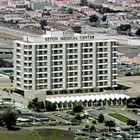
Seton Medical Center
It was over a dozen years ago that I saw my first transradial PCI. I had booked a photo shoot with Dr. Felix Millhouse at Seton Medical Center in Daly City, California, to get some shots for our web site. I did one case and was told that Dr. Millhouse was doing an urgent PCI in cath lab #2. So I went over to shoot it, but by the time I got to the lab, I was too late. I saw a man with his arm extended off the table. And Dr. Millhouse was removing his gloves. “Sorry,” he said. “We’re all done.”
It went so quickly that I had missed the procedure. But I went on to photograph the patient in the recovery room. He was sitting up, talking to his wife. And to me. He was not lying flat, with a sandbag on his groin. He was sitting up, smiling, and then got up and walked to the restroom.
This was new to me. I had produced dozens of live case demonstration courses but I was not familiar with what I was seeing.
Nor were most physicians in the U.S.
Turns out that Dr. Millhouse was one of the early adopters of a catheter-based approach called “transradial.” Instead of threading a catheter to the heart from the femoral artery in the leg/groin, Dr. Millhouse was using the radial artery in the wrist as the entry point. This approach was pioneered by Dr. Ferdinand Kiemeneij in 1992. Since then, advances in the technique and in the equipment, along with the dedication of these pioneering physicians, has brought the radial approach to the forefront, resulting in today’s paradigm-changing announcement. And I use the term”paradigm-changing” knowingly. It’s overused, to the point of being a joke to be sure. But in this case, it is totally valid!!
As the ESC guidelines state, the risk of bleeding complications is significantly reduced with the radial approach. And the patient is able to ambulate much earlier and be discharged, often without an overnight stay in the hospital.
So there are medical, economic and comfort advantages to the radial approach.
Currently in the UK and in other countries, the vast majority of PCIs are done radially. But in the United States, just 20% (optimistically) are done from the wrist. This isn’t bad, since only eight years ago, when we started our Transradial Center, the figure was 2%!!!
The U.S. has been very slow in learning and incorporating the transradial approach into common everyday practice. Our evangelism has been helpful in this, but only because of the research, data collection and teaching of those pioneering cardiologists in the U.S. We hope that the ACC and SCAI will follow suit with the Europeans and declare the transradial approach the preferred approach.
To learn more and to read interviews with some of the leaders in this field, go to our Transradial Center, which is supported by Medtronic plc.
A note here about industry support for transradial. The transradial approach requires some specialized equipment, to be sure. But all of the catheters, introducer sheaths and hemostasis devices are very low on the totem pole of profit. These are the nuts and bolts of interventional devices. Some of the companies supporting transradial are Terumo, Merit Medical, Teleflex, and Medtronic. But the real issue is learning a new technique. And for that, a physician needs to find a mentor, or attend a course.
Speaking of finding a mentor and a training opportunity, check out AIMRadial 2015. It’s beng held in a few weeks in the UK, Liverpool, September 17-19. Meet the pioneers. Check it out!
BTW, Seton Medical Center (pictured at the top) was one of the centers of angioplasty innovation in the 1980’s and 90’s, with Drs. Richard Myler and Simon Stertzer, who performed the first angioplasties in the U.S., teaching the first generation of interventional cardiologists how this radical new procedure was done. Dr. Millhouse was one of their first Fellows, along with Drs. Eric Topol and Barry George.




I am delighted to find your blog. Someone told me that Dr. Felix Millhouse had a distinctive career, especially in the field of stents beyond his skill in the cath lab. I met him when he did angioplasty for me and added two more stents to my collection of five. I’m pleased to find out more about this fine doctor. I’m still healthy and active 15 years after my first major heart attack, now have 13 stents as well as a pacemaker-defibrillator and I’m 76. You have provided information that interests me. My heart is (literally) better off because of all of you in this field. Thank you.